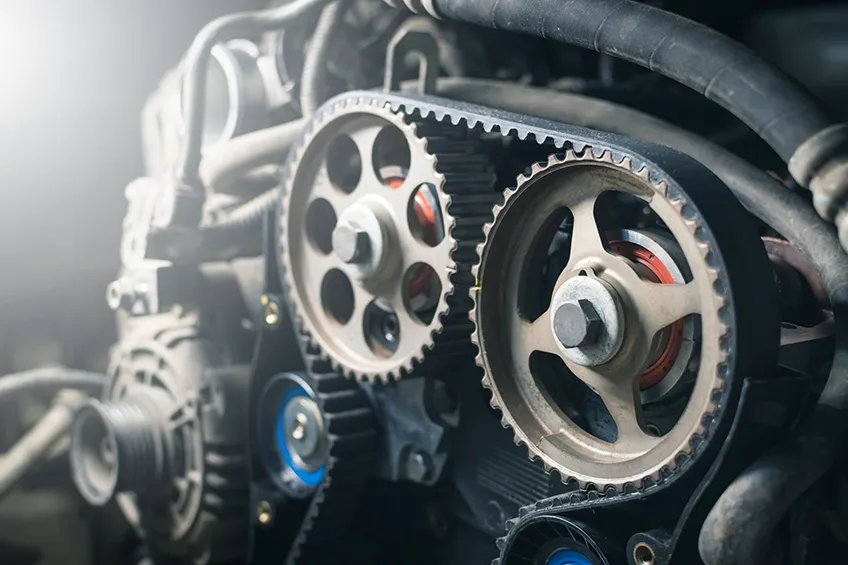What’s a Cambelt?

You may have heard of the cambelt as something that needs to be replaced at regular intervals in your car, but do you know its purpose? Knowing what a cambelt does and what can happen if you don’t have it replaced promptly can help you to better understand your car’s maintenance schedule and allow you to stay safer on the roads.
What is a timing belt?
Whether you call it a timing belt or a cambelt, this part of your vehicle’s engine is one of the most important components. It’s a wide rubber belt that is placed inside the car’s engine to keep the camshaft and crankshaft moving in sync. In doing so, the cambelt prevents the components of the top half of the engine (valves and cylinder head) from interfering with those of the bottom half (pistons and crankcase) and vice versa. As such, it is an essential item.
Do cambelts really need changing?
No matter how well you treat your vehicle, its timing belt will not last forever. Replacing it before the point of failure is crucial if you want to avoid a costly engine repair bill. Rough guidelines can help you to understand when it’s time to replace your cambelt, and you can find recommendations from the car’s manufacturer in the vehicle handbook. In addition, it’s a good idea to have your cambelt checked as part of a car service at least annually so that any wear and tear can be spotted by a trained mechanic.
Some people are reluctant to have their cambelt replaced due to the cost of having it done. While it’s understandable that the prospect of extra expense may be unpleasant, particularly if money’s tight, it’s important to know that failing to replace your cambelt is likely to cost you even more money in the long run. Replacing your vehicle’s timing belt really is the most cost-effective option.
Over time the cambelt will stretch, which can accelerate wear of the belt and cause the belt to fail without warning. In some instances, when the engine is idle, a rattling noise can be heard coming from the cambelt area. This would indicate wear on the cambelt’s tensioner and/or the idler pulleys, which in turn will also cause damage to the belt, another factor which can cause premature failure of the belt. Even if it turns out to be something other than the timing belt causing these signs, getting the problem checked out is the best thing you can do to avoid serious damage.
If the cambelt does snap, it can damage your car’s engine. As mentioned, the cambelt prevents the top and bottom half of the engine from interfering with one another. This works by moving the relevant components so that they’re never in the same place at the same time, as there often isn’t actually enough room to house all of the components when fully extended.
When the cambelt snaps, that controlling force is lost and the two halves of the engine lose their synchronicity. This can lead to components colliding violently with one another as many as a hundred times in a minute, and so causing a significant level of irreversible damage within the engine. In this situation, it’s unlikely that repairs would be worth considering. Instead, the car would likely be written off – and you’re unlikely to receive compensation through an insurance claim if it’s found that you’ve neglected to have the cambelt replaced at the appropriate time.
Directives from the DVSA state that any diesel vehicle which has not had its cambelt changed in line with the manufacturer’s recommendations should not undergo an emissions test during an MOT, as the test requires the engine to be put under a heavy load to enable an emissions reading to be obtained correctly. More information about this can be found on gov.uk/getting-an-mot.
HOW MUCH DOES IT COST TO REPLACE A CAMBELT?
The cost of a cambelt replacement naturally depends on where you go to get the work carried out. For a fair price and a professional service, get in touch with your local Mr Clutch Autocentre, where our helpful staff will be eager to help you evade vast repair bills caused by a cambelt failure.
We operate a Fixed Price Cambelt Schedule which is based on your car’s engine size and the number of cams. Most vehicles will commonly have a twin cam, however, we are happy to inspect your vehicle to determine the number of cams, as well as advising on your manufacturer’s recommended cambelt change intervals. During most cambelt replacements it is recommended to have a new water pump fitted too, which is an additional cost and can slightly extend how long the cambelt replacement takes, but it’ll save you time and money in the long run for the mechanic to do this task while they’re already working on this area of the engine.
UPDATED